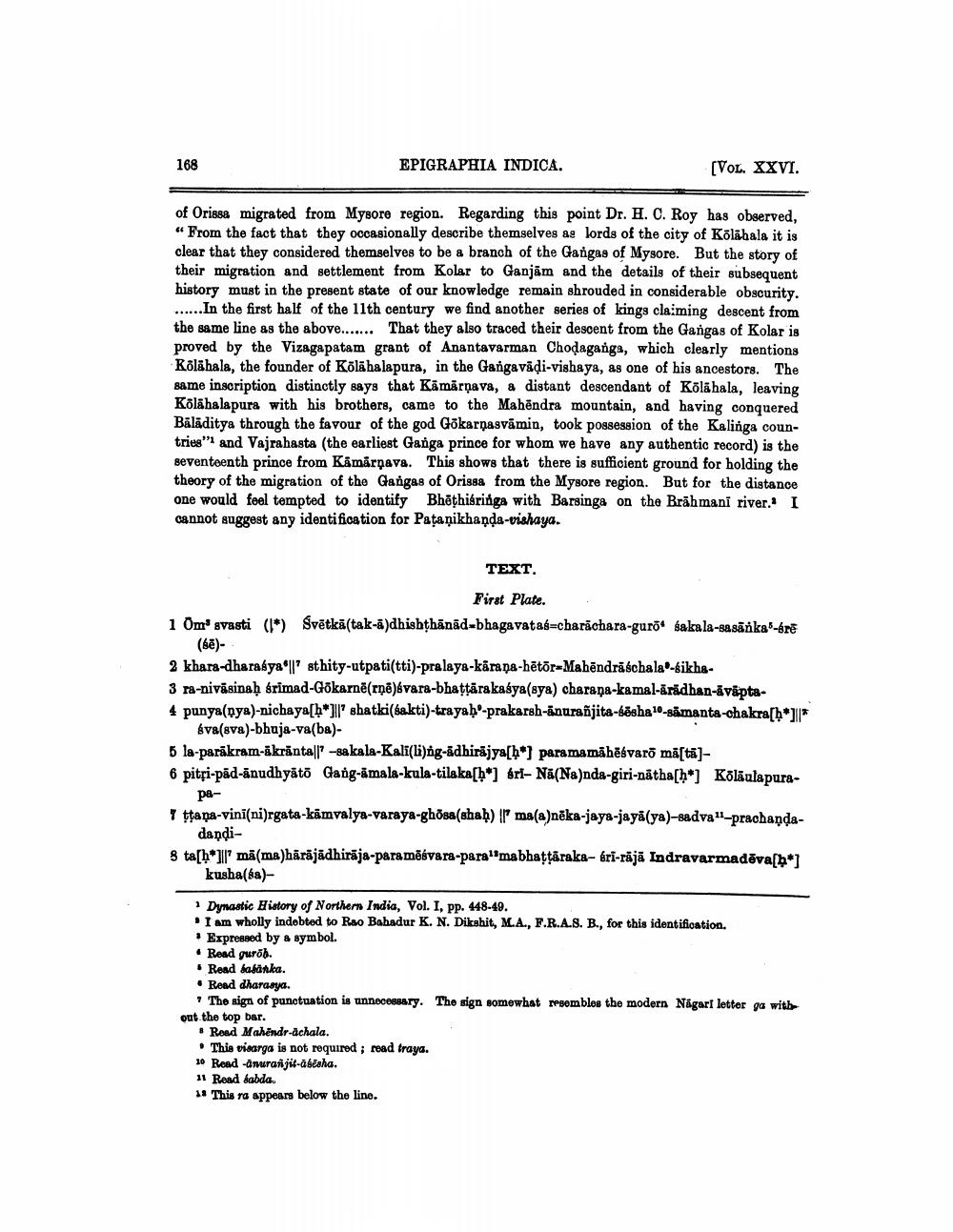________________
168
EPIGRAPHIA INDICA.
(VOL. XXVI.
of Orissa migrated from Mysore region. Regarding this point Dr. H. C. Roy has observed, "From the fact that they occasionally describe themselves a, lords of the city of Kölähala it is clear that they considered themselves to be a branch of the Gangas of Mysore. But the story of their migration and settlement from Kolar to Ganjām and the details of their subsequent history must in the present state of our knowledge remain shrouded in considerable obscurity. ...... In the first half of the 11th century we find another series of kings claiming descent from the same line as the above....... That they also traced their descent from the Gangas of Kolar is proved by the Vizagapatam grant of Anantavarman Chodaganga, which clearly mentions Kölähala, the founder of Kölāhalapura, in the Gangavādi-vishaya, as one of his ancestors. The same inscription distinctly says that Kämärņava, a distant descendant of Kölāhala, leaving Kölāhalapura with his brothers, came to the Mahendra mountain, and having conquered Bäläditya through the favour of the god Gökarnasvāmin, took possession of the Kalinga countriug"'1 and Vajrahasta (the earliest Ganga prince for whom we have any authentic record) is the seventeenth prince from Kamarnava. This shows that there is sufficient ground for holding the theory of the migration of the Gangas of Orissa from the Mysore region. But for the distance one would feel tempted to identify Bhēthisringa with Barsinga on the Brahmani river. I cannot suggest any identification for Pataņikhanda-vishaya.
TEXT.
First Plate. 1 Om svasti (l*) Svētkā(tak-ā)dhishthānād-bhagavatag=charāchara-guro* sakala-sasānka-kre
(bē)2 khara-dharabya'll sthity-utpati(tti)-pralaya-karana-hētõr-Mahēndrāschala-sikha3 ra-nivāsinah srimad-Gökarnē(rņē)bvara-bhattārakaśya(sya) charana-kamal-ārädhan-āvāpta4 punya(nya)-nichaya[h*]ll'shatki(sakti)-trayab'-prakarsh-anurañjita-sēsha-samanta-chakra[b]*
sva(sva)-bhuja-va(ba). 6 la-parakram-äkrintal -sakala-Kali(li)ng-adhirajya[b*) paramamābēsvarā māstā]6 pitsi-pād-anudhyāto Gang-amala-kula-tilaka[h*] bri- Nā(Na)nda-giri-nātha[h*] Köläula pura
paT ttana-vini(ni)rgata-kāmvalya-varaya-ghosa(shah) Ilma(a)nēka-jaya-jayā(ya)-sadva"-prachanda
dandi8 ta[h*ll' mä(ma)hārājādhirāja-paramāśvara-para''mabhattāraka-bri-rājā Indravarmadēva[h*]
kusha(sa)
* Dynastic History of Northern India, Vol. I, pp. 448-49.
I am wholly indebted to Rao Bahadur K. N. Dikshit, M.A., F.R.A.8. B., for this identification. • Expressed by & symbol. • Read gurob. . Read basatka. • Read dharasya.
The sign of punctuation is unnecessary. The sign somewhat resomblon the modern Någari letter ga with out the top bar.
# Road Mahendr-achala. . This visarga is not required; read traya. 10 Read -anuranjit-abisha. 11 Read dabda. 11 This ra appears below the line.




